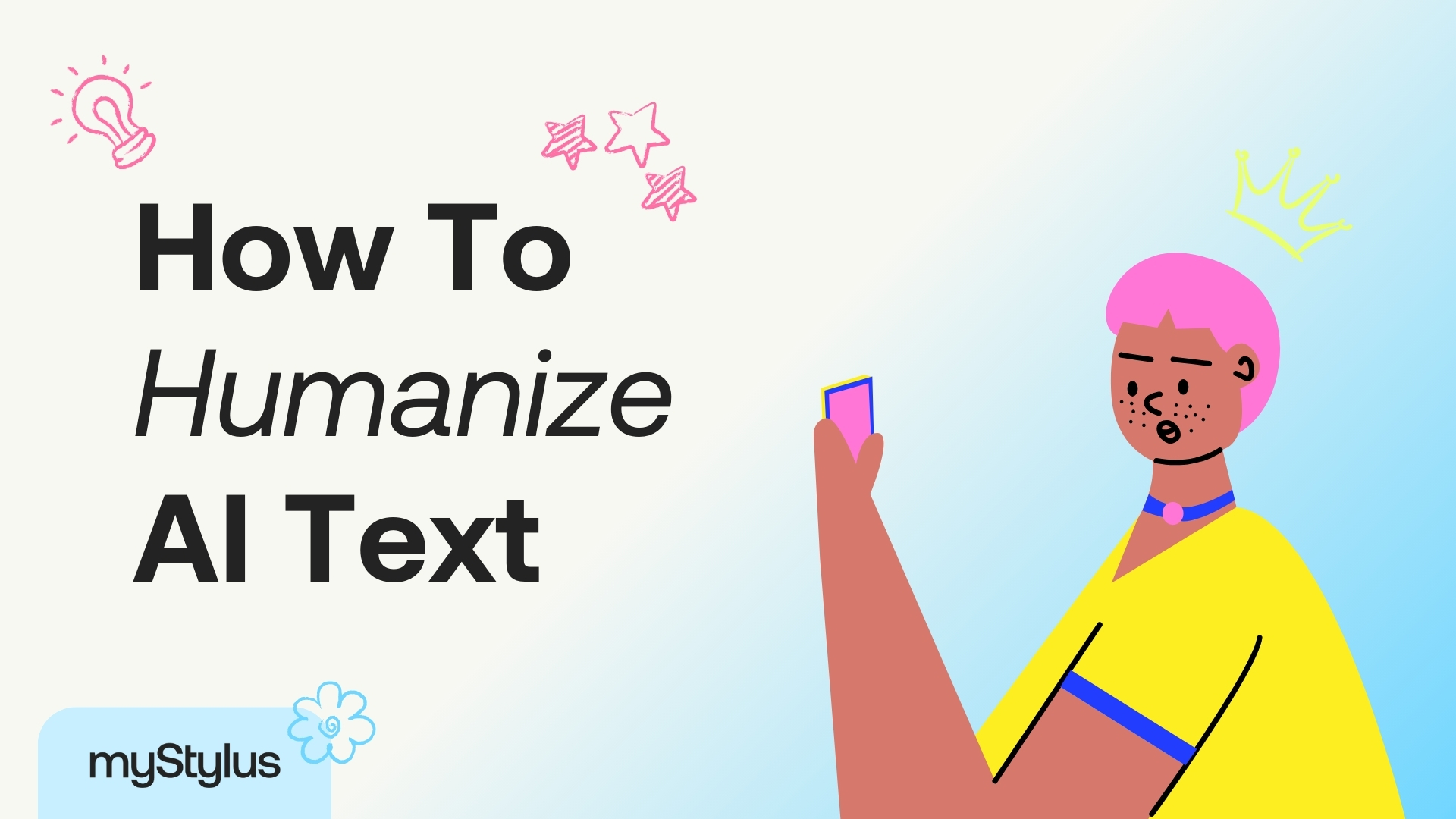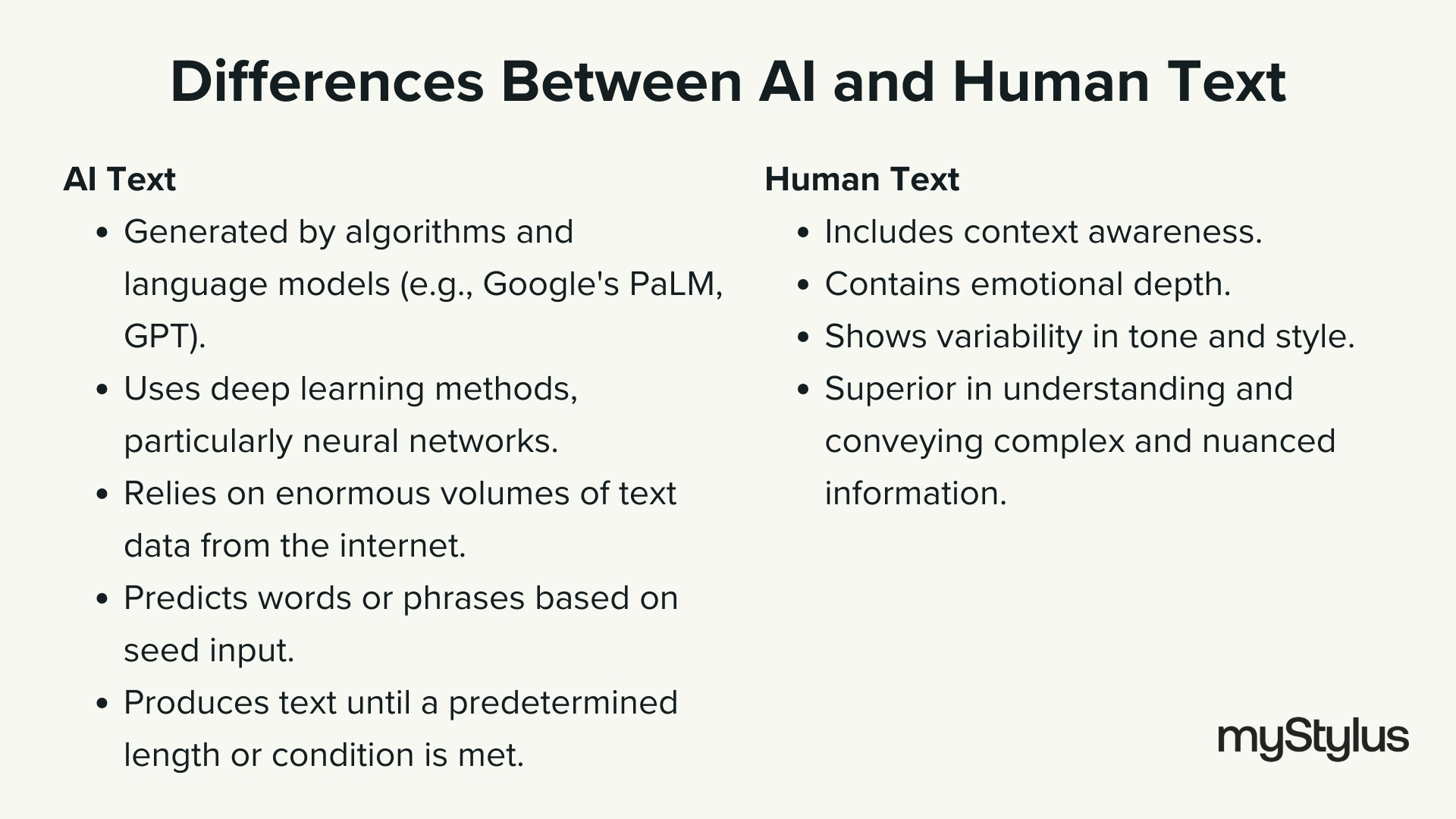How To Humanize AI Text
- January 17, 2025
- 7 mins read

Recently, there has been a strong boom in the use of AI to handle various tasks. Among these tasks, using AI for writing is now commonplace, making an appearance in a large spectrum of fields, from science to blogs.
Professionals and students alike use websites like ChatGPT to generate papers for a variety of reasons. However, AI-written content brings with it rigidity and a lack of context, and sometimes it may even include incorrect information or exclude objectivity.
This constant use creates a need for users of generative tools to learn how to humanize AI-generated text. Humanizing this content makes it sound more natural and relatable, making it a better read, easy to understand, and familiar to human audiences.
MyStylus was created to make the process of humanizing AI less hectic, as you do not necessarily need to refine your work.
It automatically finds and adds the best adapters (LoRAs, textual inversions, hypernetworks) to Stable Diffusion based on your prompt.
The Chasm Between Human Work and Machine-Generated Content
In order to understand the difference between AI and human text and how to convert AI text to human text, we need to understand how AI text generation works.
There are generally three types of AI: artificial narrow intelligence in voice assistants such as Siri, Alexa, or Google Assistant; artificial general intelligence, which involves machines understanding and performing vastly different tasks; and artificial superintelligence, which is a system that could hypothetically learn and continually improve itself.
Text generation finds applications in real-world scenarios such as content creation, chatbots, language translation, and summarization. To process input data and produce output text, it uses language models and algorithms.
Language models, like Google’s PaLM and GPT (Generative Pre-trained Transformer), which have been trained on enormous volumes of text data from the internet, are the foundation of text production.
These models use deep learning methods, particularly neural networks, to comprehend sentence structure and produce coherent and appropriate content for the context.
During the text generation process, the AI model uses its acquired knowledge to anticipate the most likely words or phrases after a seed input, such as a sentence or keyword.
The model keeps producing text until a predetermined length or condition is satisfied, while adding context and coherence. This automated generator presents major benefits, such as increased efficiency, improved personalization, and language accessibility.
However, unlike human text, it also features some limitations, such as a lack of contextual understanding, overreliance on training data, difficulty handling rare issues on which it doesn’t have enough data, and absence of emotional nuance.
In this way, human text may be considered superior because it includes context awareness, emotional depth and variability in tone and style. This leads to the need to humanize AI.

Useful Methods for Humanizing AI Text
Even though AI writing tools are efficient and convenient, their work frequently lacks the organic flow and personal touch that readers find engaging. This is where the need to humanize AI text comes in.
“Humanizing AI text” refers to the process of transforming the robotic, stilted language that AI models produce into content that sounds human-written. This procedure is essential for several reasons:
- It facilitates eluding AI detectors such as Turnitin and Originality.ai, which can penalize or exclude content that is detected as AI-generated.
- Because natural, conversational language tends to connect better with human viewers, it increases engagement and trust.
- Even while using AI writing aid, it enables you to keep your brand’s language and tone constant.
These methods include:
Using The Latest and Best Models
There is a lot of work and research going into AI, and that has seen the development of newer, better models which should be faster and smarter than their older versions. To enhance your written content quality, it is best to use enhanced language models such as GPT-4 or higher for generation.
These models use extensive training data to understand and replicate human-like conversational patterns. As such, for advanced users, learning how to humanize AI content may include training models on diverse datasets to improve contextual and cultural understanding.
Leveraging methods like sentiment analysis, contextual embeddings, and fine-tuning on a variety of excellent datasets, the AI is able to provide responses that exhibit personality, humor, and empathy.
Different AI models provide different levels of responses, with basic models providing the most simplistic and vague explanation. For example, GPT 2 provides clear and informative information but lacks depth and nuance compared to its descendants.
GPT 3 responses on a similar topic as in GPT 2 are articulate, include additional aspects of the topic, and offer a well-rounded explanation but still lack the engagement factor.
GPT-4’s response shows a deeper understanding and maybe even more human-like conversational intonation.
Differences Between GPT-3 and GPT-4
Some enhanced models, such as MyStylus, which uses the most advanced model, may not require humanizing. They are detailed, highly nuanced and engaging, covering multiple dimensions of the given topics.
Refining Prompts
Humanizing AI-written content using specific prompts involves crafting prompts that guide the AI to produce responses with a more natural, engaging, and human-like tone.
Effective prompts provide context, specify tone, and outline the desired style, whereas poor prompts are vague and lead to generic, robotic responses.
The AI needs all this context to deliver its best approximation of necessary details and emotions and make it more engaging. Here is an example of a good prompt that can help you humanize text: “Describe the benefits of renewable energy in a way that is engaging and persuasive, focusing on its impact on climate change and job creation.”
Bad prompts tend to appear too general and lacking in context. They result in bland and uninspired responses that don’t engage the reader. For example, “Explain renewable energy.”
This prompt leads to a shallow and generic response that only defines renewable energy without in-depth content on the topic. By using specific prompts, we can unleash the full potential of AI to create content that feels more genuine and relatable.
Providing Context to Generate Deeper Answers
Context is all about making a piece of information make even more sense. The more information you can give about something, the more people can find it relatable and engaging. This approach to humanize AI writing makes the results more appealing and easier for readers to connect with.
Here is an example to illustrate the difference context makes in information delivery.

To effectively add context in a way that makes you relatable, identify relatable scenarios, infuse emotion at appropriate times, use vivid imagery, and include specifics.
Using Literary Devices and Poetry in Language
To make AI text more human is to use the literary devices we love. That involves incorporating figurative language to make the writing more engaging, relatable, and vivid.
When reworked using these techniques, AI-generated content can be given a level of expressiveness and appeal that closely mirrors human writing, making it more enjoyable and effective for readers on a level that possesses emotion.
Metaphors, similes, personification, alliteration, hyperbole, and other literary devices can all inject a uniquely human way of using language into a generated piece of text.

Thorough Editing and Fact-Checking
Fact-checking and editing is the process of verifying the accuracy of claims made in a piece of content.
It humanizes AI-written material, ensuring correctness, relevance, and clarity by verifying the information and meeting the demands of the audience.
This process makes the output more reliable and engaging for the reader. Some of the ways to do this include:
- Cross-referencing the AI-generated content with reputable sources to ensure the information is correct
AI detection tools can’t always detect lies or falsehoods, so it’s important to fact-check AI-generated content to avoid getting erroneous information. For example,
Prompt: “Explain the benefits of renewable energy.”
AI Response: “Renewable energy can reduce carbon emissions by 90% within five years.”
Fact-Checked Response: “Renewable energy significantly reduces carbon emissions, with studies showing a potential decrease of up to 70% by 2050 when combined with energy efficiency improvements.”
- Editing for clarity and engagement, which refines the text’s readability.
- Adding the human touch makes the text more relatable.
By incorporating these steps, AI-to-human text conversion makes the results not only informative but also compelling.
Using AI Checkers
Another great way to humanize AI generated content involves employing specialized tools that can identify text generated by checking it for known hallmarks of AI content.
These detectors help refine the output by highlighting areas that seem artificial or overly formal and allowing for targeted editing. When learning how to humanize AI text for free, you can check out free AI detector tools such as Copyleaks, Grammarly, and Hemingway Editor.
The most sophisticated checkers can identify each AI’s telltale signs. All you have to do is paste the AI-generated text into the tool, review the suggestions for clarity, tone, and readability, and make the necessary edits to humanize the text.
It is worth noting that these tools can make mistakes and should not be completely relied upon. It is sometimes possible to detect human work as AI and the other way around, which leaves much to be desired in the way of their effectiveness.
An Exploration of Case Study Lessons to Humanize Writing
Humanizing AI has successfully been done using various methods that you may find useful when learning how to make AI text more human. To hammer that point home, let’s look at case studies.
One such example is the use of AI text in customer service. The models can be frustrating and unhelpful, but when humanized, they can be a remarkable success in enhancing the overall customer experience.
Through the strategic utilization of natural language processing and sentiment analysis, these AI chatbots were adept at understanding and responding to user queries with personalized and empathetic language, effectively simulating human interaction.
They also yielded substantial cost savings for companies by efficiently handling routine customer inquiries, thereby allowing human agents to focus on more complex and high-value interactions.
Furthermore, it has the potential to mitigate language barriers and cultural differences by offering multilingual support tailored to diverse customer bases.
Another great case study would be Duolingo, a language learning app that uses AI to generate practice exercises and responses. Initially, these responses were accurate but lacked personality, making the experience less engaging.
However, Duolingo integrates humor, cultural references, etc., resulting in user engagement and satisfaction. It made the content more enjoyable, leading to improved retention rates.
Another significant case study would be Grammarly, a writing assistant tool that uses AI to provide writing suggestions. Earlier versions focused on grammatical correctness, often producing stiff texts.
Grammarly introduced context-sensitive suggestions that considered tone, formality and clarity, acting as an AI-to-human text converter. Users found the suggestions more helpful and aligned with more human-sounding writing styles.
The tool’s ability to offer varied tone adjustments, such as making text more confident or polite, added significant value.
The best practices for humanizing AI include the following:
- Understanding your audience
- Using specific prompts
- Using literary devices
- Editing for tone and style
- Adding emotional and sensory details
- Incorporating storytelling.
As they state it on their website, “At Grammarly, our goal is to make it possible for everyone to be heard and understood. But there’s no single set of rules that will work for every person in every situation. The beauty of AI is that it can combine many types of information and adjust to the situation at hand.”
AI and Cultural Sensitivity in Writing
Humanizing AI texts means making them relatable, respectful, and context-aware. Cultural sensitivity is a key part of this process. For example, an AI might generate content using idioms, phrases, or humor that align with one culture but are confusing—or even offensive—to another. Without proper context, AI may also overlook cultural traditions, societal norms, or the values that shape how people communicate and relate.
To address this, users must guide AI with detailed, culturally specific prompts. For instance, when creating content for a particular audience, including information about their language preferences, customs, and sensitivities helps the AI produce text that feels more personal and genuine. Reviewing and editing AI-generated content for tone, relevance, and inclusivity further ensures it meets the expectations of a human audience.
Developers are also working to make AI more culturally aware by training models on diverse datasets and adding tools like sentiment analysis. However, even the most advanced AI requires human involvement to ensure accuracy and respect for cultural differences.
Augment AI With Human Writing Finesse
In conclusion, the potential of AI in content creation is undeniable. However, to truly resonate with human audiences, AI-generated writing needs a touch of humanity.
By incorporating the strategies outlined in our coverage of the topic, you can begin to learn how to humanize AI-written text to bridge the gap between machine and man.
As AI writing continues to evolve, embracing these methods will ensure it not only informs but also connects, entertains, and inspires qualities that are inherently human and ultimately define truly impactful communication.
Remember, AI is a powerful tool, but the human element remains the guiding force in crafting truly compelling content; this is why MyStylus generates human-like texts from the first try. This means you need not edit the text in order to make it sound more human.
Resources
- Ali Awan, A. (2023). What is text generation. Retrieved May 22, 2024, from https://www.datacamp.com/blog/what-is-text-generation
- Arshad, M. (2024, May 9). Stylus: An AI Tool that Automatically Finds and Adds the Best Adapters (LoRAs, Textual Inversions, Hypernetworks) to Stable Diffusion based on Your Prompt. MarkTechPost. https://www.marktechpost.com/2024/05/09/stylus-an-ai-tool-that-automatically-finds-and-adds-the-best-adapters-loras-textual-inversions-hypernetworks-to-stable-diffusion-based-on-your-prompt/
- Bigdata. (2023, December 22). Case studies: Successful applications of Humanized AI text in business. Big Data Analytics News. https://bigdataanalyticsnews.com/applications-of-humanized-ai-text-in-business/
- “How We Use AI to Enhance Your Writing | Grammarly Spotlight.” Grammarly Spotlight: How We Use AI to Enhance Your Writing, 17 May 2019, www.grammarly.com/blog/how-grammarly-uses-ai.
FAQ
-
What does it mean to make AI text human?
Making AI text human means breathing life into it! We infuse facts with feeling, add personality, emotions, and captivating stories, transforming data into something that truly connects with readers and ditching robot-speak for a natural voice. It's about bridging the gap between the machine and the reader. -
What are the main differences between AI-generated text and human-written text?
AI writes like a machine: fast, factual, but lacks emotional punch. Humans weave stories, inject feelings, crafting a more relatable experience. People can connect with readers on a deeper level when they write an essay. -
Why does humanizing AI writing matter at all?
AI writing can be factual and efficient, but it often lacks the warmth, personality, and emotional connection that resonates with human readers. Humanizing your AI writing makes it more engaging, relatable, and memorable. -
How can I add personality to AI-generated content?
Give it a voice: Imagine the type of person you want your writing to sound like. Is it a friendly expert, a casual storyteller, or a passionate advocate? Tailor the tone and vocabulary to match that voice.
Show, don't tell: Instead of stating facts, use vivid descriptions, anecdotes, and metaphors to paint a picture for the reader. -
What are some effective methods to change AI text to human text?
Transform AI text to human text by simplifying language, ensuring natural phrasing, and adding personal touches. You might try using the humanizer tool or plagiarism fixer from some website for these tasks. Also, tailor the content to the audience and infuse it with appropriate emotion and tone. -
Are there any tools to help humanize AI writing?
You can use an online rewriter to humanify and rewrite AI-generated text to make it sound more natural and engaging. Some AI writing platforms offer features to adjust tone and style. Additionally, you can paraphrase and edit the AI output to inject your own voice and personality. -
How to humanize AI writing?
The art of humanizing text in AI writing lies in adopting a conversational tone, employing relatable language, and adding personal touches to captivate readers and create a more authentic experience.